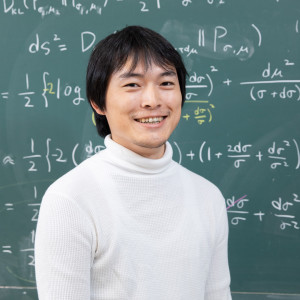Volume 155
Back to Newsletter List
Event Schedule
Events for the 4th week of June 2021
2021-06-17
Monday, June 21, 13:00- iTHEMS Theoretical Physics Seminar
Wednesday, June 23, 13:30- Information Theory SG Seminar
Thursday, June 24, 16:30- DMWG Seminar
Friday, June 25, 12:30- Coffee Meeting
Upcoming Events
Seminar
iTHEMS Math Seminar
Stable eigenvalues of compact anti-de Sitter 3-manifolds
June 18 (Fri) 16:00 - 18:10, 2021
Kazuki Kannaka (Special Postdoctoral Researcher, RIKEN Interdisciplinary Theoretical and Mathematical Sciences Program (iTHEMS))
Geometric objects that have been investigated in detail so far, such as closed Riemann surfaces, are sometimes locally homogeneous. Loosely speaking, their infinitesimal behavior is the same at each point. In this talk, I would like to explain the idea of investigating such objects using the Lie group theory.In the first part of the talk, I will recall the notions of Lie group actions and their quotient spaces with examples, and then explain the definitions of locally homogeneous spaces and their deformations (Teichmüller spaces). In the second part of the talk, I will consider anti-de Sitter manifolds as a special case, i.e., Lorentzian manifolds of negative constant curvature. As in the Riemannian case, a differential operator called the Laplacian (or the Klein-Gordon operator) is defined on Lorentzian manifolds. Unlike the Riemannian case, it is no longer an elliptic differential operator but a hyperbolic differential operator. In its spectral analysis, new phenomena different from those in the Riemannian case have been discovered in recent years, following pioneering works by Toshiyuki Kobayashi and Fanny Kassel. I would like to explain stable eigenvalues of the hyperbolic Laplacian of anti-de Sitter 3-manifolds with recent progress.
Venue: via Zoom
Event Official Language: English
Seminar
iTHEMS Theoretical Physics Seminar
Black Hole Information Paradox and Wormholes
June 21 (Mon) 13:00 - 14:30, 2021
Kanato Goto (Special Postdoctoral Researcher, RIKEN Interdisciplinary Theoretical and Mathematical Sciences Program (iTHEMS))
In this talk, I will explain about the recent progress in the black hole information paradox that I am involved with. The information paradox arises when a black hole evaporates by emitting Hawking radiation due to the quantum effects. Time dependence of the entropy of Hawking radiation is diagnosis of information loss caused by the black hole evaporation. If information is not lost, the entropy of Hawking radiation should obey the so-called Page curve. In recent research developments, it was found that “the quantum extremal islands” reproduce the unitary Page curve in an evaporating black hole. I will argue about how the quantum extremal islands are derived from the computation of the entropy of Hawking radiation using the gravitational path-integral.
Reference
Venue: via Zoom
Event Official Language: English
Seminar
Information Theory Seminar
Introduction to the replica method
June 23 (Wed) 13:30 - 15:40, 2021
Yoshiyuki Kabashima (Professor, Graduate School of Science, The University of Tokyo)
The replica method is a mathematical technique for evaluating the "quenched" average of logarithm (or a real number power) of the partition function with respect to predetermined random variables that condition the objective system.
The technique has a long history, dating back at least to a book by Hardy et al in 1930s, but has become well known only since its application to the physics of spin glasses in 1970s. More recently, its application range is spreading rapidly to various fields in information science, including information theory, communication theory, signal processing, computational complexity theory, machine learning, etc.
In this talk, we introduce the basic idea of the replica method and its mathematical fault illustrating a few examples.
*Detailed information about the seminar refer to the email.
Venue: via Zoom
Event Official Language: English
Seminar
DMWG Seminar
Precise WIMP Dark Matter Abundance and Standard Model Thermodynamics
June 24 (Thu) 16:30 - 17:30, 2021
Satoshi Shirai (Project Assistant Professor, Kavli Institute for the Physics and Mathematics of the Universe (Kavli IPMU), The University of Tokyo)
We are now living in the era of precision cosmology. The relic abundance of dark matter (DM) is now observationally well-determined, and its error is smaller than O(1)%. This means that the same or much higher precision is required when we make theoretical predictions.
Weakly Interacting Massive Particle (WIMP) has long been the leading candidate for DM because of its beautiful mechanism to predict the observed relic abundance. WIMP is in the same thermal bath as the Standard Model particles in the beginning. At a certain point when the temperature of the Universe is smaller than the DM mass, it decouples to fix its number density. The yield of the DM is determined by its annihilation cross-section to the Standard Model sector.
It seems that there is no ambiguity in the calculation of this process at first: the cross-section is purely theoretical and all the remainings are described in the Standard Model physics. However, the source of the uncertainty does remain in the Standard Model sector. The dilution of the number density of DM particle depends on the expansion rate of the Universe, which is determined by the Standard Model particles. The effective degree of freedom (d.o.f) of the relativistic species controls this factor. We have to deal with the non-equilibrium dynamics to precisely describe the time-evolution of the d.o.f, in which we need numerical approaches.
In this talk, he introduced his work to update these calculations. By implementing the latest findings in the non-equilibrium dynamics in i) the neutrino decoupling, ii) the QCD phase transition, iii) the electroweak phase transition, and iv) the perturbative calculations, they found that the final d.o.f is smaller than the previous estimate in more than 1%. This is larger than the level of precision in observations. It is also important that the uncertainty is quantified by them.
Another good news is that he makes the calculated d.o.f with its error publically available. With these updates, we now correctly know the points to probe DM!
Venue: via Zoom
Event Official Language: English
External Event
RIKEN Day: Let's Talk with Researchers! "Can Artificial Intelligence Draw Pictures?"
June 25 (Fri) 18:00 - 18:30, 2021
Akinori Tanaka (Senior Research Scientist, RIKEN Interdisciplinary Theoretical and Mathematical Sciences Program (iTHEMS))
In the June RIKEN Day, we will have a talk with Akinori Tanaka, a researcher who is researching on the theme of "Can Artificial Intelligence Draw Pictures?"
See related links for details.
Venue: via Zoom
Event Official Language: Japanese
Seminar
iTHEMS Math Seminar
An introduction to modular functions, conformal field theories, and moonshine phenomena
July 2 (Fri) 16:00 - 18:10, 2021
Mizuki Oikawa (Junior Research Associate, RIKEN Interdisciplinary Theoretical and Mathematical Sciences Program (iTHEMS) / Student Trainee, RIKEN Interdisciplinary Theoretical and Mathematical Sciences Program (iTHEMS) / Ph.D. Student, Graduate School of Mathematical Sciences, The University of Tokyo)
Moonshine phenomena are certain mysterious connections between modular functions and finite groups. The first example is the celebrated monstrous moonshine, which connects the J-invariant and the Monster group. Surprisingly, this relationship can be well understood in terms of chiral conformal field theory. In this talk, I would like to explain what is chiral conformal field theory and how it gives moonshine phenomena.
In the first part of the talk, the notion of modular function will be introduced and the precise statement of the monstrous moonshine will be given. Then the monstrous moonshine will be explained in terms of vertex operator algebra, a mathematical model of chiral conformal field theory.
In the second part of the talk, we focus on the question: what is chiral conformal field theory mathematically? In addition to vertex operator algebras, other mathematical models of chiral conformal field theory, namely conformal nets and Segal conformal field theories, will be introduced. Recent progress on the relationship among these three models, including the Carpi--Kawahigashi--Longo--Weiner correspondence and the geometric realization of conformal nets will also be reviewed.
Venue: via Zoom
Event Official Language: English
Colloquium
iTHEMS Colloquium
Quantitative Population Dynamics in Interdisciplinary Biology
July 8 (Thu) 10:30 - 12:00, 2021
Shingo Iwami (Professor, Graduate School of Science, Nagoya University)
Through the course of life, from the moment of birth till death, an organism will achieve various states of equilibrium or ‘homeostasis’ which will inevitably encounter perturbations. The processes of cell growth, differentiation, infection, mutation, evolution and adaptation work together as a coordinated ‘system’, described by mathematical models for population dynamics, to maintain a healthy state. Any disruptions to this system leads to disease including infection, allergy, cancer, and aging. We are conducting interdisciplinary research to elucidate “Quantitative Population Dynamics” through the course of life with original mathematical theory and computational simulation, which are both our CORE approach. Our mathematical model-based approach has quantitatively improved a current gold-standard approach essentially relying on the statistical analysis of “snapshot data” during dynamic interaction processes in life sciences research. In this talk, I will explain how our interdisciplinary approach extends our understanding for complicated clinical data and apply real world problem with an example of the Novel Coronavirus Disease, COVID-19.
Venue: via Zoom
Event Official Language: English
Person of the Week
Self-introduction: Yantao Wu
2021-06-11
My name is Yantao Wu. I joined iTHEMS in June 2021. My research field is in computational and theoretical statistical physics. I'm also interested in quantum computing. I obtained my PhD in physics from Princeton University in May 2021. During graduate school, I have worked on renormalization group of quantum and classical statistical systems in the context of Monte Carlo simulations. I'm also quite familiar with path-integral molecular dynamics. Currently, I'm interested in developing tensor network algorithms for quantum dynamics in one dimension and ground state calculations in two dimensions. In particular, I'm interested in the approximate canonical form of 2D tensor networks, and its associated entanglement structure. I'm also interested in issues related to quantum dynamics, such as entanglement evolution and eigenstate thermalization hypothesis at the edge of the energy spectrum. I'm based in UC Berkeley, and would be glad to host any iTHEMS visitors in the bay area. Based in UC Berkeley, I have recently got interested in the hardware of quantum computing as well. I hope that we can one day see the ENIAC of our generation. In my spare time, I like soccer, climbing, poetry, and Go (not very good though).
Paper of the Week
Week 3, June 2021
2021-06-17
Sorry for the pile of new papers due to system error.
Title: Emergence of the $ρ$ resonance from the HAL QCD potential in lattice QCD
Author: Yutaro Akahoshi, Sinya Aoki, Takumi Doi
arXiv: http://arxiv.org/abs/2106.08175v1
Title: Spatial variations of magnetic field along active galactic nuclei jets on sub-pc to Mpc scales
Author: Soichiro Ito, Yoshiyuki Inoue, Jun Kataoka
arXiv: http://arxiv.org/abs/2106.01788v1
Title: Simulated quantum annealing as a simulator of non-equilibrium quantum dynamics
Author: Yuki Bando, Hidetoshi Nishimori
arXiv: http://arxiv.org/abs/2106.00928v1
Title: A simple numerical method for Hele-Shaw type problems by the method of fundamental solutions
Author: Koya Sakakibara, Yusaku Shimoji, Shigetoshi Yazaki
arXiv: http://arxiv.org/abs/2105.14811v1
Title: Neutron star asteroseismology and nuclear saturation parameter
Author: Hajime Sotani
arXiv: http://arxiv.org/abs/2105.13212v1
Title: Analytical WKB theory for high-harmonic generation and its application to massive Dirac electrons
Author: Hidetoshi Taya, Masaru Hongo, Tatsuhiko N. Ikeda
arXiv: http://arxiv.org/abs/2105.12446v1
Title: Cross-match between the latest Swift-BAT and Fermi-LAT catalogs
Author: Naomi Tsuji, Hiroki Yoneda, Yoshiyuki Inoue, Tsuguo Aramaki, Georgia Karagiorgi, Reshmi Mukherjee, Hirokazu Odaka
arXiv: http://arxiv.org/abs/2105.11791v1
Title: Complex Langevin study for polarons in an attractively interacting one-dimensional two-component Fermi gas
Author: Takahiro M. Doi, Hiroyuki Tajima, Shoichiro Tsutsui
arXiv: http://arxiv.org/abs/2105.11072v1
Title: A global numerical model of the prompt emission in short gamma-ray bursts
Author: Hirotaka Ito, Oliver Just, Yuki Takei, Shigehiro Nagataki
arXiv: http://arxiv.org/abs/2105.09323v1
Title: Gamma-ray and Neutrino Signals from Accretion Disk Coronae of Active Galactic Nuclei
Author: Yoshiyuki Inoue, Dmitry Khangulyan, Akihiro Doi
arXiv: http://arxiv.org/abs/2105.08948v1
Title: On the Hubble constant tension in the SNe Ia Pantheon sample
Author: Maria Giovanna Dainotti, Biagio De Simone, Tiziano Schiavone, Giovanni Montani, Enrico Rinaldi, Gaetano Lambiase
arXiv: http://arxiv.org/abs/2103.02117v4
If you would like to cancel your subscription or change your email address,
please let us know via our contact form.
Copyright © iTHEMS, RIKEN. All rights reserved.








